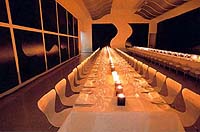| Candle burning suggestions |
| * never leave burning candles unattended and always burn candles in heat and fire resistant holders. |
| * trim candle wick if the candle flame smokes or flickers. Generally a wick length of 1cm will give a good clean burn and decent flame size. |
| * burn thick candles for at least 2 hours each time to generate a wide wax pool. This will help prevent the wick from burning deep into the candle and is especially important the first time you burn the candle. |
* ensure that the wick is not submerged in wax when extinguishing the candle. It is best to keep the wick as vertical as possible as the candle burns to help ensure that the candle burns evenly. This can be done by pushing it with a metal object while the candle burns.
|
| *
avoid burning candles in draughty locations or near curtains and bedding.
If burning candles in draughty conditions, rotating them occasionally
as they burn will help promote even burning. |
| * tealight candles in aluminium shells become extremely hot when nearing the end of the wax, and the wax can flare (burn without a wick). This is because there is less wax for the heat to be dissipated into so it gets hotter. For this reason never touch a burning tealight candle. Blow them out and let them cool before handling. Always burn tealights in holders. It is a good idea to put a coin under them to help absorb the heat. |
| * votive candles are designed to turn too liquid as they burn. As such they need to be burnt in an appropriate cup holder. |
| * most candles will fade over time as the dyes used in them are somewhat unstable. Sunlight in particular will fade candles. Thin or long candles are also prone to bending in warm weather so it is advisable to store these candles on flat surfaces in cool conditions. |
|
| Other
good advice including wax cleaning and removal tips |
